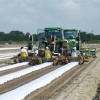 With the new fumigant regulations and rising cost of crop production, including fumigants, it would be desirable to reduce the standard use rate of soil fumigants. The use of higher-barrier, gas-impermeable mulches may make it possible to reduce fumigant application rates by helping to contain the fumigant longer within the soil and reduce overall emissions into the atmosphere. The results of field studies show that fumigant application rates can be reduced by 20 to as much as 40% through the use of virtually impermeable or the more gas-tight TIF mulch films at the time of application. This 5-page fact sheet was written by J. W. Noling, and published by the UF Department of Entomology and Nematology, March 2013.
With the new fumigant regulations and rising cost of crop production, including fumigants, it would be desirable to reduce the standard use rate of soil fumigants. The use of higher-barrier, gas-impermeable mulches may make it possible to reduce fumigant application rates by helping to contain the fumigant longer within the soil and reduce overall emissions into the atmosphere. The results of field studies show that fumigant application rates can be reduced by 20 to as much as 40% through the use of virtually impermeable or the more gas-tight TIF mulch films at the time of application. This 5-page fact sheet was written by J. W. Noling, and published by the UF Department of Entomology and Nematology, March 2013.
http://edis.ifas.ufl.edu/in403
Tag: Fumigants
Proper Calibration of Soil Fumigant Application Equipment (ENY047/IN404)
 Calibration of soil fumigant equipment and determination of soil fumigant application rate are two of the most important factors contributing to the success or failure of pest control efficacy and crop production response, yet generate some of the greatest confusion among many researchers and growers alike. This 5-page fact sheet was written by J.W. Noling, and published by the UF Department of Entomology and Nematology, December 2012.
Calibration of soil fumigant equipment and determination of soil fumigant application rate are two of the most important factors contributing to the success or failure of pest control efficacy and crop production response, yet generate some of the greatest confusion among many researchers and growers alike. This 5-page fact sheet was written by J.W. Noling, and published by the UF Department of Entomology and Nematology, December 2012.
http://edis.ifas.ufl.edu/in404
Soil Fumigation after Methyl Bromide: Managing Concentrations of Drip-Applied Metam Potassium for Nutsedge Control (HS1201)
 This 2-page fact sheet presents the results of studies conducted to determine the influence of metam potassium concentrations on purple nutsedge control. Written by Bielinski M. Santos and James P. Gilreath, and published by the UF Department of Horticultural Sciences, April 2012.
This 2-page fact sheet presents the results of studies conducted to determine the influence of metam potassium concentrations on purple nutsedge control. Written by Bielinski M. Santos and James P. Gilreath, and published by the UF Department of Horticultural Sciences, April 2012.
http://edis.ifas.ufl.edu/hs1201
HS1166 Methyl Bromide Fumigant REDs Regulations Overview
HS1166, a 10-page fact sheet by Andrew M. MacRae and Joseph Noling, provides growers, applicators, and owner/operators with an overview of new mitigation measures and reporting requirements for methyl bromide. Published by the UF Department of Horticultural Sciences, April 2010.
http://edis.ifas.ufl.edu/hs1166
HS1167 Overview of New EPA Regulations Affecting Use of Metam Sodium and Metam Potassium
HS1167, a 10-page fact sheet by Andrew MacRae and Joseph Noling, provides a a general overview of the new mitigation measures growers and certified applicators will be required to implement, based on the new reregistration eligibility decisions (REDs) for metam sodium and metam potassium. Published by the UF Department of Horticultural Sciences, April 2010.
http://edis.ifas.ufl.edu/hs1167
HS1168 Chloropicrin Fumigant REDs Regulations Overview
HS1168, a 10-page fact sheet by Andrew MacRae and Joseph Noling, provides an overview of the new measures that will be required for fumigant applicators and growers using chloropicrin. Published by the UF Department of Horticultural Sciences, May 2010.
http://edis.ifas.ufl.edu/hs1168
PI228 EPA’s Safety Measures for Aluminum and Magnesium Phosphide Fumigants
PI228, a 2-page illustrated fact sheet by F.M. Fishel, outlines new EPA restrictions on aluminum and magnesium phosphide products used to control burrowing rodents. Includes references. Published by the UF Department of Agronomy, May 2010.
http://edis.ifas.ufl.edu/pi228
HS1174 Proper Application of the 3-Way Fumigant System for the Post-Methyl-Bromide Era
HS1174, a 2-page fact sheet by Andrew W. MacRae, describes the 3-Way system — using a combination of three fumigants to achieve control of nematodes, diseases, and weeds — as a methyl-bromide alternative for the control of soilborne pests, and discusses considerations for growers in selecting fumigant systems. Published by the UF Department of Horticultural Sciences, May 2010.
http://edis.ifas.ufl.edu/hs1174
HS1169 Maximizing the Efficacy of Soil Fumigant Applications for Raised Bed Plasticulture Systems of Florida
HS1169, a 5-page fact sheet by Andrew MacRae, Joseph Noling, and Crystal Snodgrass, describes several factors in crop production that should be considered to maximize the efficacy of alternatives to methyl bromide. Published by the UF Department of Horticultural Sciences, April 2010.
http://edis.ifas.ufl.edu/hs1169
ENY901/IN818 Optimizing Alternative Fumigant Applications for Ornamental Production in Florida
ENY-901, a 6-page illustrated fact sheet by Erin N. Rosskopf, N. Kokalis-Burelle, R. McSorley & E. Skvarch, presents the results of tests of two alternative fumigants for ornamental production, conducted in Gainesville and Ft. Pierce. Includes references. Published by the UF Department of Entomology and Nematology, June 2009.
http://edis.ifas.ufl.edu/IN818